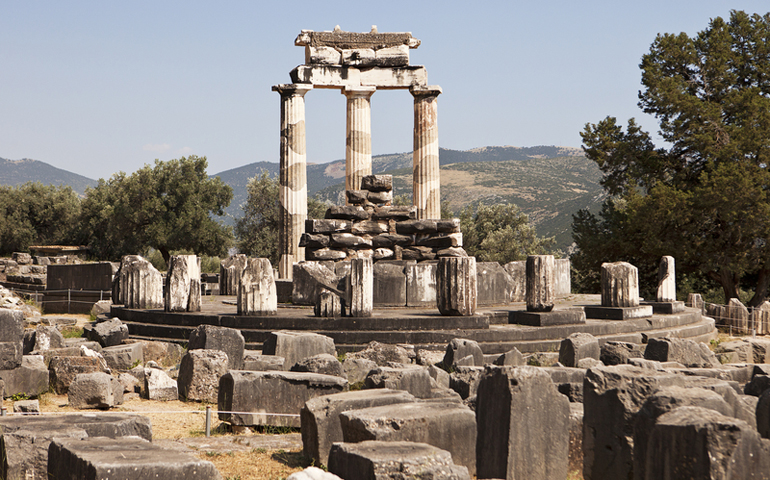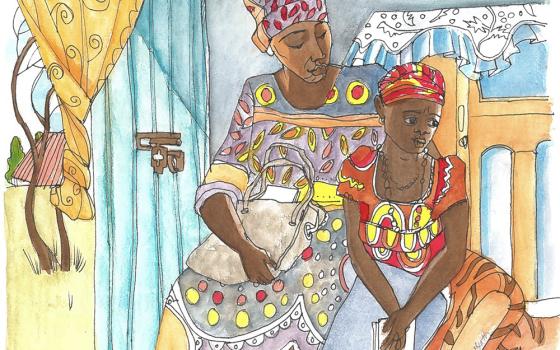
The ruins of the sanctuary of Athena at Delphi (Dreamstime)
Back in 1990, I took a journey to Greece with a classmate from the seminary. In Delphi, we stood on the hill overlooking the ruins of the ancient shrine. At one time, it was the spiritual center of the ancient Mediterranean world. For more than 800 years, people flocked to consult the famed oracle, bathe in the springs and worship in temples of Apollo and Athena. Today, nobody comes to worship. It is a ruin, an archeological museum. Looking at the shrine, I wondered out loud to my classmate: "Could this happen to us? Could what happened in Delphi happen in Rome?"
Religions rise. Religions fall. Is the Catholic church going out of business?
It's a fair question.
Religion seems to be disappearing from Western culture, the homeland of Roman Catholicism.
The Pew Research Center report "America's Changing Religious Landscape" documented the rise of the religiously unaffiliated among American adults. The so called "nones" rose from 16 percent of American adults in 2007 to 23 percent in 2014. In the United States, all Christian groups lost "market share": Evangelicals were down 0.9 percent, Catholics down 3.1 percent, and mainline Protestants down 3.4 percent.
In only seven years, American Catholics lost about 3 million adult members, easily wiping out every single convert we made through RCIA, the Rite of Christian Initiation of Adults.
No matter how hard we paddle in the new evangelization, we are carried downstream by the current of culture. A Religion News Service analysis on the Pew study carried the headline: "Forget the numbers. The big story is that religion has lost social influence."
This is especially true for young adults, who are increasingly unaffiliated with religion. Only about 56 percent of young millennials (people born between 1990 and 1996) have a religion, while 78 percent of baby boomers are church members. As the boomers die off, the church declines.
A look at the statistics about the Catholic church in the U.S. may give us cause to think we are "circling the drain." A few bullet points tell the tale:
- In the last 25 years, we have a net loss of 2,137 parishes nationwide: In 1990, there were 19,620 U.S. Catholic churches. Today, there are 17,464.
- The New York archdiocese announced the consolidation of 112 parishes in October 2014, effectively closing 31 parishes. In December, it announced that it is considering closing another 38 parishes.
- The Boston archdiocese has closed more than 125 parishes in the past 25 years. In November 2012, it announced the consolidation of the remaining 288 parishes into 135 "parish collaboratives."
- In the Chicago archdiocese, Catholics declined from 43 percent of the population in 1980 to 35 percent in 2015. Chicago had 1,000 fewer priests in 2014 than it had in 1980. In last 20 years of Cardinal Francis George's administration, everything was down: 2,000 fewer nuns, 21 fewer parishes, 74 fewer elementary schools and 11 fewer high schools. There were also 10,000 fewer baptisms, half as many weddings, and 33 percent fewer funerals annually.
- Nationwide, Catholic priests are an endangered species. Today, there are 3,496 U.S. parishes that have no resident pastor. There are nearly 20,000 fewer priests in the United States than there were 25 years ago, dropping from 52,124 to 38,275.
- Half the diocesan priests in the United States will retire in the next five years. Many dioceses in the U.S. do not have sufficient funds to pay their pensions.
- Religious orders of brothers and sisters are disappearing even faster than diocesan priests. There are only about 50,000 U.S. nuns today, down from almost 180,000 in 1965. The only really bright spot in the vocations picture is the permanent deaconate. We have more than 17,000 permanent deacons, up from about 900 in 1975. Maybe marriage helps.
- Sacramental participation is way down. Today, only 24 percent of U.S. Catholics go to Mass on a typical Sunday. In 1970, it was closer to 50 percent. In 2014, there were less than half as many Catholic weddings as in 1980; more than 200,000 fewer infant baptisms than in 1980; and 50,000 fewer funerals than in 1990.
Of course, things vary from place to place. There was growth in the South and West, mostly because of migration and demographic shifts. But overall, there is decline.
Internationally, we have even bigger problems. The passage of the same-sex marriage referendum in Ireland by 62 percent indicates the church has lost authority on sexual issues. In Vienna, the archdiocese announced a plan in 2012 to close more than 500 parishes over the next 10 years, reducing their parishes from 660 to 150 because of a shortage of priests. Every day in Latin America, we lose thousands to evangelicals and Pentecostals.
So it's not a foolish question. Are we going out of business?
I think the answer is both "yes" and "no." "Yes" if you think of the church as an institution in the 1950s model. "No" if you think of the church as a movement of the followers of Jesus Christ.
The parish of my childhood -- church, school, rectory, convent -- is mostly gone. Almost half of the Catholic schools in the United States have closed in the last 40 years: In 1965, there were 11,198 schools; today, there are 6,793. We cannot hang on to institutions. We are not maintainers of buildings.
For us priests, it is discouraging. We have to wonder, have we wasted our lives?
In my little world, things are fine. The pews in my parish are mostly full. The bills are paid. But I can't help but hear the echo of problems in other places. Worst of all, much of our decline comes from self-inflicted wounds, the sins of priests.
But the church has faced challenges before. It has survived the fall of the Roman Empire, the Black Death, the Protestant Reformation and the European Enlightenment. It survived various revolutions, be they French, Russian, industrial or scientific.
The conservative critique is exhausted. We cannot turn back the clock or ignore the changed cultural landscape. This is not a matter of liturgical style or catechetical instruction. The natural sciences trump Scripture today. Women in our culture are no longer subservient to or dependent on men. Gay people have finally found their voice and their self-respect in Western culture. Clericalism is dead.
It is no good for the church to shout, "Women, back to the kitchen! Nuns, back to the cloister! Laity, back to your pews! Gays, back in the closet!" The toothpaste is out of the tube. We can no more bring back the church of the 1950s than we can bring back the Papal States.
Despite all, I'm looking forward in hope. Something will rise in the ruins of the old church. People will still need religion. We will always look for ways to make life holy, happy and sacred. We still have souls. People need ritual to grieve and celebrate. We always will seek meaning, desire forgiveness and wonder about death.
The church is relevant so long as the teaching of Jesus is relevant. As the Letter to the Hebrews says, "Christ is the same yesterday, today and forever" (Hebrews 13:8).
Institutions come and go, but the Gospel goes on, speaking to the human heart.
So can Delphi happen in Rome? Yes. Perhaps it already has.
[Fr. Peter Daly is the pastor of St. John Vianney parish in Prince Frederick, Md.]
Editor's note: We can send you an email alert every time Fr. Peter Daly's column, "Parish Diary," is posted to NCRonline.org. Go to this page and follow directions: Email alert sign-up.



